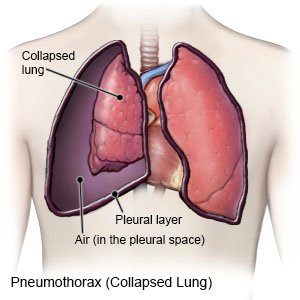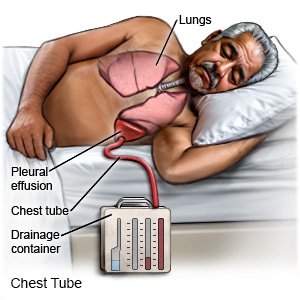Spontaneous Pneumothorax
Medically reviewed by Drugs.com. Last updated on Aug 4, 2025.
A spontaneous pneumothorax is a collapsed lung. Part or all of the lung may collapse. Air collects in the pleural space (the space between the lungs and chest wall). The trapped air prevents your lung from filling, and the lung collapses. A spontaneous pneumothorax can happen in one or both lungs. A primary spontaneous pneumothorax occurs in a person with no known lung problems. A secondary spontaneous pneumothorax occurs in a person who has a known lung disease or medical condition.
 |
WHILE YOU ARE HERE:
Informed consent
is a legal document that explains the tests, treatments, or procedures that you may need. Informed consent means you understand what will be done and can make decisions about what you want. You give your permission when you sign the consent form. You can have someone sign this form for you if you are not able to sign it. You have the right to understand your medical care in words you know. Before you sign the consent form, understand the risks and benefits of what will be done. Make sure all your questions are answered.
A pulse oximeter
is a device that measures the amount of oxygen in your blood. A cord with a clip or sticky strip is placed on your finger, ear, or toe. The other end of the cord is hooked to a machine.
Medicines:
- Antibiotics prevent or treat a bacterial infection.
- Pain medicine may be given. Do not wait until the pain is severe before you ask for more medicine.
Tests:
- Blood tests are used to check your oxygen and carbon dioxide levels. The results can tell healthcare providers how well your lungs are working.
- A heart monitor is used to record your heart's electrical activity.
- X-ray This is a picture of the bones, lungs, and other tissues in your chest. Healthcare providers use chest x-rays to see if you have broken ribs. These x-rays may show your healthcare provider how large your pneumothorax is. Chest x-rays may also show fluid around the heart and lungs.
- CT scan or ultrasound pictures may be used to check for a pneumothorax that did not show up on a chest x-ray. You may be given contrast liquid to help your lungs show up better in the pictures. Tell the healthcare provider if you have ever had an allergic reaction to contrast liquid.
Treatment:
- Extra oxygen may be given if your oxygen level is too low. Oxygen may help the pneumothorax get better faster.
- Needle aspiration is used to pull the air out of your pleural space through a needle.
- A chest tube may be placed to remove air, blood, or fluid from around your collapsed lung. This allows your lung to fill up with air when you breathe, and helps your heart beat normally. The chest tube is attached to a container to remove air and collect any blood or fluid.

- Pleurodesis is a procedure used to irritate the walls of your pleural space. This causes the walls to close so air can no longer be trapped.
- Surgery may be used to repair your lung.
RISKS:
Air may continue to enter the pleural space and you may get a tension pneumothorax. With a tension pneumothorax, the injured lung and trapped air push against your uninjured lung. A tension pneumothorax can lead to low blood pressure, decreased oxygen in your blood, and heart problems.
CARE AGREEMENT:
You have the right to help plan your care. Learn about your health condition and how it may be treated. Discuss treatment options with your healthcare providers to decide what care you want to receive. You always have the right to refuse treatment.© Copyright Merative 2025 Information is for End User's use only and may not be sold, redistributed or otherwise used for commercial purposes.
The above information is an educational aid only. It is not intended as medical advice for individual conditions or treatments. Talk to your doctor, nurse or pharmacist before following any medical regimen to see if it is safe and effective for you.
Learn more about Spontaneous Pneumothorax
Treatment options
Care guides
Further information
Always consult your healthcare provider to ensure the information displayed on this page applies to your personal circumstances.
